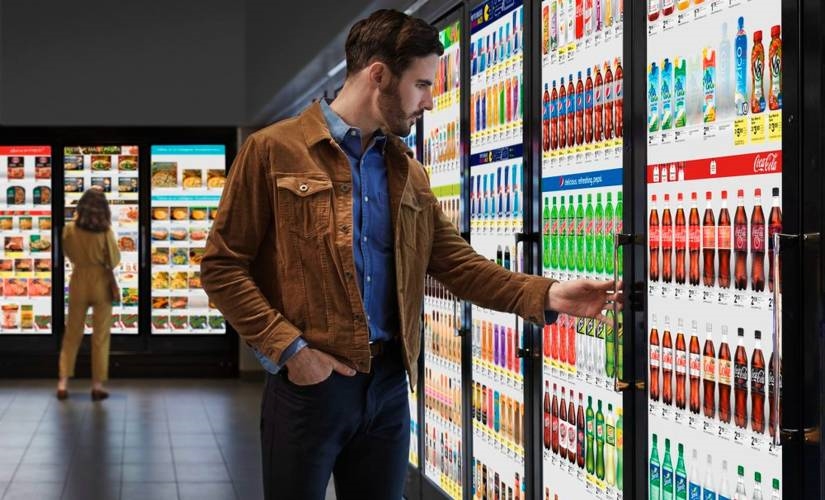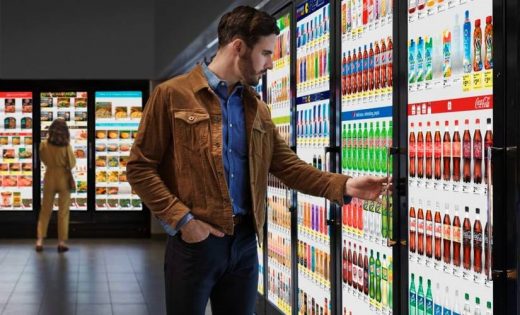How IoT-Enabled Smart Screens Are Changing the Face of Retail Media
How IoT-Enabled Smart Screens Are Changing the Face of Retail Media

Think about walking into a grocery store just five years ago. You’d head to the freezer section, pick up a pint of ice cream, and head home. The whole transaction was pretty simple. It didn’t involve interacting with smart screens at all.
Today, you might scroll Instagram and see an ad for a subscription ice cream service. You might tell Alexa to remind you to pick up ice cream after work. Your significant other might text you asking for cookies and cream with chocolate syrup, so instead of just getting a cone for yourself, you decide to take a different route home to pass the grocery store. You use Waze on your car’s dash display to miss the traffic. Finally, you go into the store, listening to a summer bop on your wireless headphones. The music puts you in the mood to buy popsicles, too. You leave the store with your purchases in hand.
All of those touchpoints represent just a few of the IoT experiences throughout your day. But none of them are controlled by the retailer where you’re actually purchasing your ice cream (unless you count the self-checkout).
How can retailers tap into the IoT revolution?
Using IoT Technology to Enhance the Customer Experience
The answer, according to one company, is through cooler doors.
The company, aptly named Cooler Screens, was founded in response to a void in the consumer experience—brick-and-mortar retailers just didn’t have much IoT connectedness. So Cooler Screens designed IoT-enabled smart screens to provide customers with a better shopping experience combining what they love about online shopping—ease, relevance, transparency—to their experience in-store.
These particular screens have multiple ad functionalities, including full door and banner ads, nutrition labels and filters. When consumers are within six feet of the screens sensors switch and showcase products when customers are near on a digital planogram with real-time pricing and promotions.
The real benefit to the consumer—that would keep them coming back for more—is the ability for the screens to clearly display sale information and nutrition facts. This prevents squinting. It reduces the need to open the door to check various items. It also helps inform better decisions based on budget and dietary needs.
Helpful Reminders Can Also Boost Sales
The screens can also encourage bundling products, such as ice cream and toppings. This serves both the retailer, who sells more units, and the consumer, who enjoys an ice cream sundae at the end of the day.
Thought leaders say the future of IoT lies in facilitating positive outcomes for businesses and consumers. Cooler Screens certainly falls in that category.
Another example of IoT devices facilitating positive outcomes would be the price-check scanners that have long occupied the aisles at Target and Walmart. Smartwatches with Apple Pay, Square card readers that plug into cell phones, payment devices at restaurant tables, even iPads with patient information in hospital rooms—all of these applications benefit the customer.
Retailers, then, should be asking themselves a few questions.
Am I using technology to help customers enjoy an efficient and pleasant experience, like the pharmacy chain that imagined using IoT plus AR to help customers navigate the store easily? Or, am I allowing old technology or a lack of technology to bog down my customers’ experience—and thus discouraging them from returning? Am I making it easy for customers to find items and pay for them, or am I slowing them down?
Using IoT and AR to Support Supply Chains
Another potential benefit of these doors: tracking grocery store inventory in real-time and using that data for modeling to mitigate supply chain issues.
Part of the allure of the Cooler Screens technology is its ability to provide data to store owners, suppliers, and marketers. The technology does this without collecting personally identifiable information, perhaps hitting a sweet spot in the privacy-versus-information debate.
That data can be quickly assessed and used to make purchasing, stocking, and supply decisions. There are no guarantees it could prevent another panic-buying toilet paper shortage. However, sharing data rather than just a visual of empty shelves could provide peace of mind to consumers.
How would stores stock their shelves and racks differently with this information? Theoretically, this data could predict consumer behavior, reduce food and clothing waste, and increase profit margins. Quickly sharing information up and down the supply chain could also lead to more agile movement along the chain.
Small Retailers Benefit from IoT, Too
The use of IoT technology doesn’t just apply to big retailers, either.
The beekeeper at the farmer’s market can leverage IoT devices to take card payments and to direct browsing visitors to her social media accounts. The boutique clothing store owner can have customers sign up for a digital waitlist for popular clothing items. The health food store owner can share digital coupons and a monthly newsletter to build trust with the community.
In these ways and more, increasing the usage of reliable IoT technology can help retailers increase sales as well as brand loyalty.
IoT Technology is Ubiquitous—and Will Only Grow
We carry smartphones and smartwatches. Many of us have smart devices attached to our lights, fans, speakers, locks and thermostats. We work from Bluetooth keyboards on computers while Netflix streams to our smart TVs.
We’ve surrounded ourselves with IoT technology in our daily life. So it only makes sense that retailers get in on the trend and help create a seamless full-circle technology experience.
Cooler Screens provides an interesting use case for retail usage of IoT devices. Their pilot data showed that 90 percent of consumers surveyed preferred the smart screen shopping experience to a traditional shopping experience. Retail unit sales in smart screen-equipped cooler sections also grew 50-100 percent higher than other comparable stores in the area.
In the future, screens could ostensibly be used for much more than advertising and showing off items.
It’s likely they will be used to continue improving the customer experience. They could become voice-enabled, so customers could ask for directions to a certain item. Stores using IoT technology could increase the use of touchscreens (or, better yet, touchless screens) and contactless payment options. Customers could view sample products and order items to be shipped to their homes. With this kind of innovation, the retail experience just might stay in the digital game.
Featured Image Credit: Cooler Screens. Thank you!
The post How IoT-Enabled Smart Screens Are Changing the Face of Retail Media appeared first on ReadWrite.
(32)


